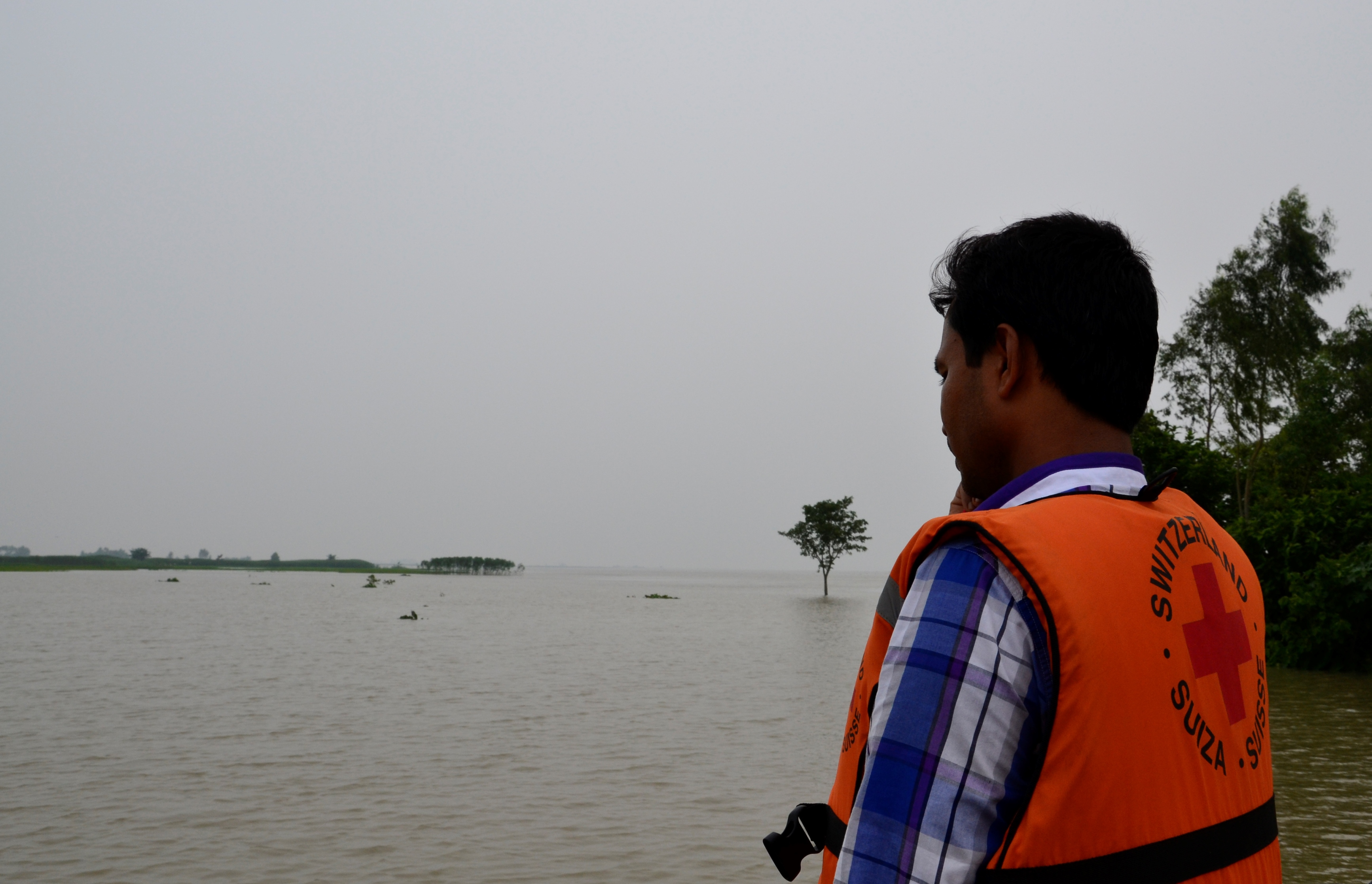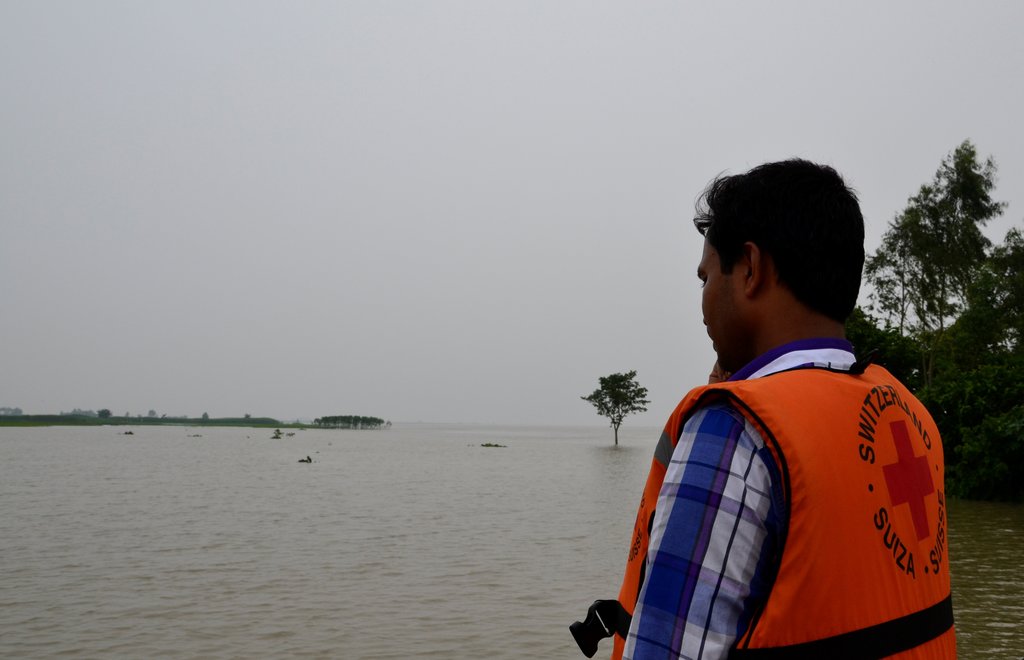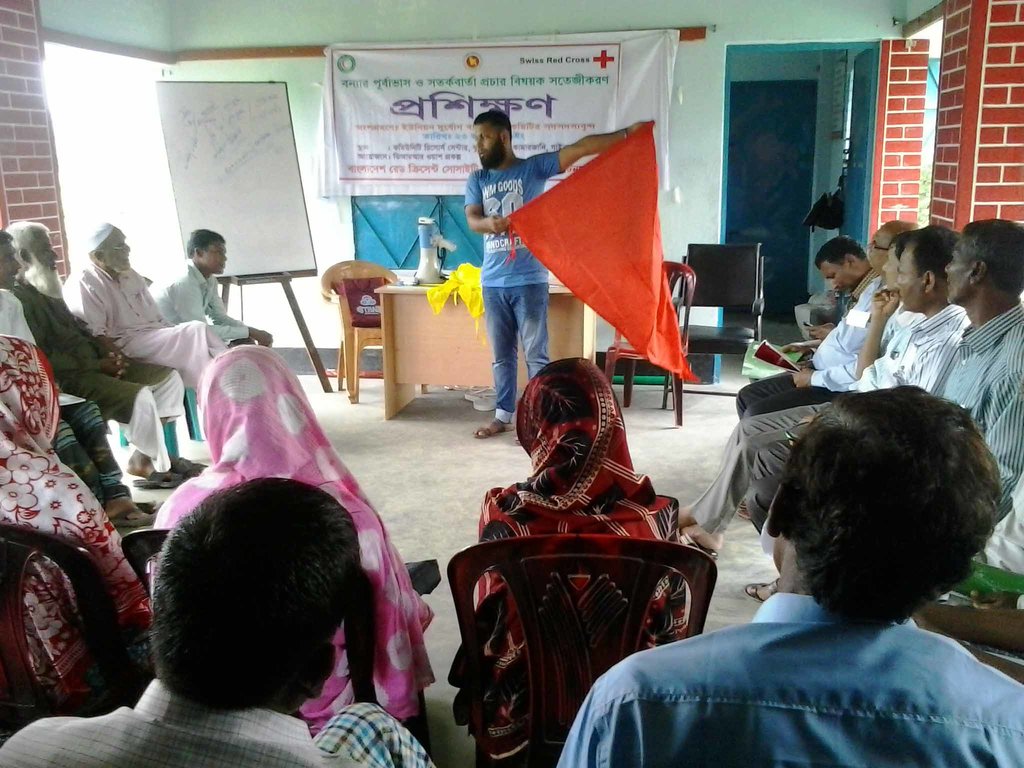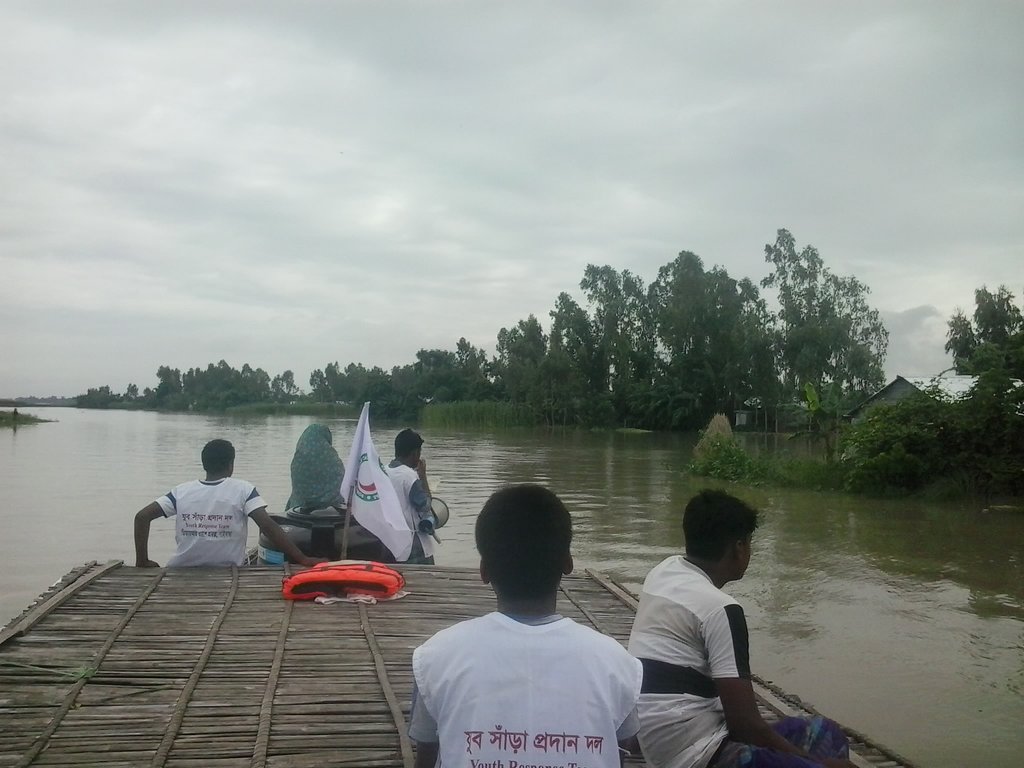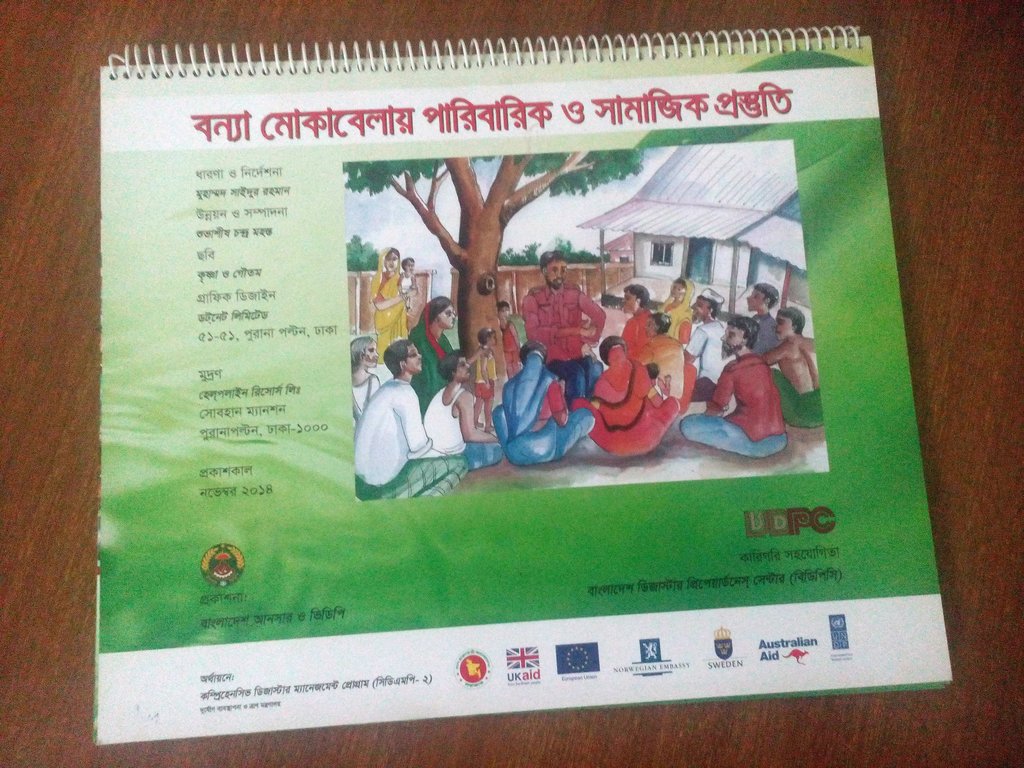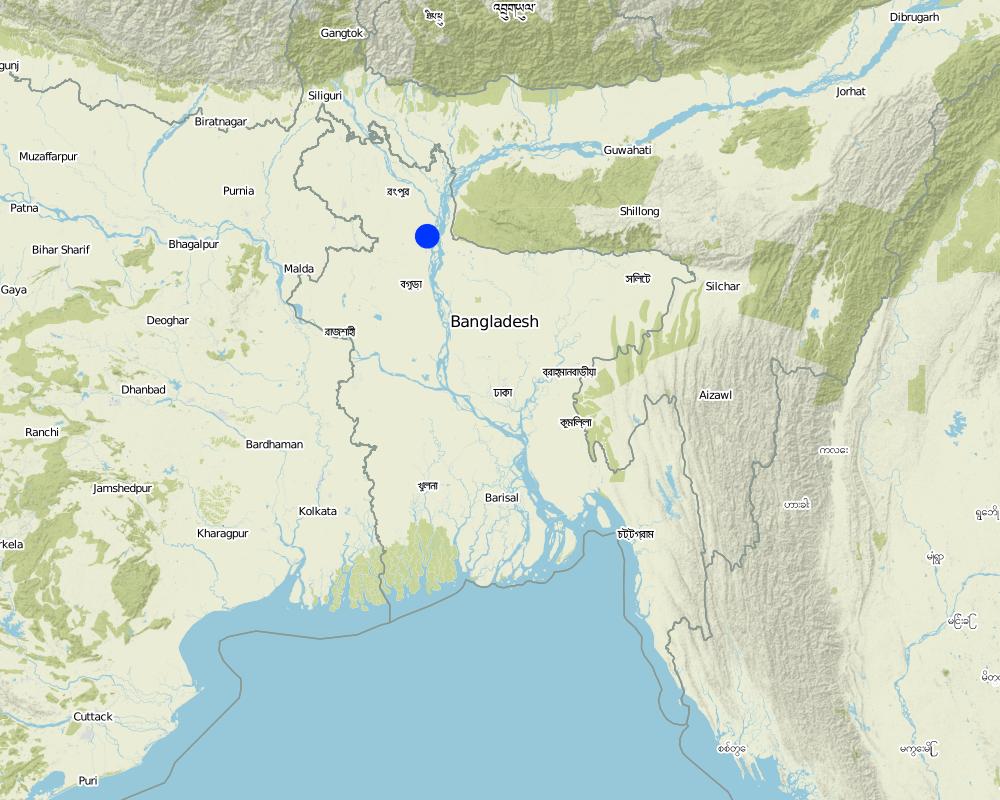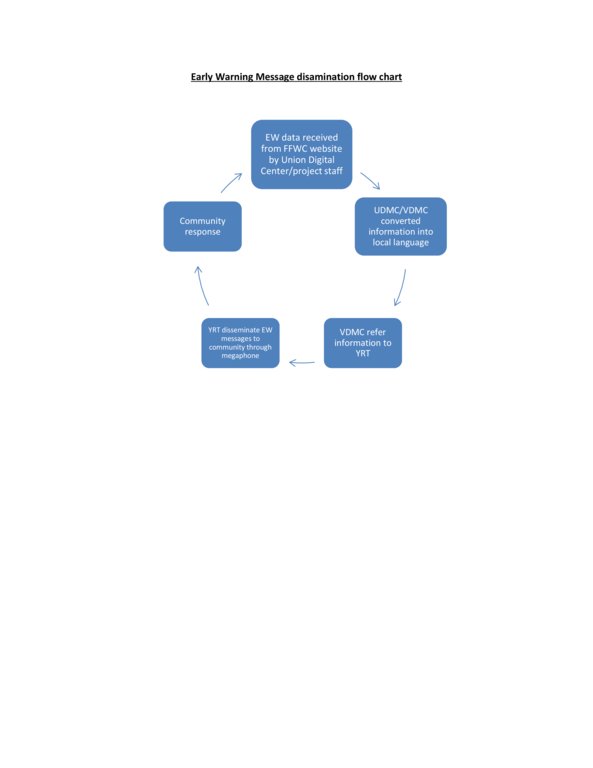Early Warning Message Dissemination [ប្រទេសបង់ក្លាដែស]
- ការបង្កើត៖
- បច្ចុប្បន្នភាព
- អ្នកចងក្រង៖ TUHIN SAMADDAR
- អ្នកកែសម្រួល៖ Anton Jöhr
- អ្នកត្រួតពិនិត្យច្រើនទៀត៖ Alvin Chandra, Alexandra Gavilano
বন্যা পূর্ব-সতর্কবার্তা প্রচার (Bonna Purbo-Satarkabarta Prochar)
approaches_649 - ប្រទេសបង់ក្លាដែស
ពិនិត្យមើលគ្រប់ផ្នែក
ពង្រីកមើលទាំងអស់ បង្រួមទាំងអស់1. ព័ត៌មានទូទៅ
1.2 ព័ត៌មានលម្អិតពីបុគ្គលសំខាន់ៗ និងស្ថាប័នដែលចូលរួមក្នុងការវាយតម្លៃ និងចងក្រងឯកសារនៃវិធីសាស្ត្រផ្សព្វផ្សាយ
បុគ្គលសំខាន់ម្នាក់ (ច្រើននាក់)
Project staff:
Mustafa Golam
+880 1718770373 / +880 1730799762
pmdrrwash16@gmail.com
Bangladesh Red Crescent Society
Project Manager, DRRWASH Project O⌀ਈce, Shukhsantir Bazar, Dhanghora, Gaibandha, Bangladesh
ប្រទេសបង់ក្លាដែស
Project staff:
Razzak Abdur
+880 1730 799763 / +880 1730 799763
razzak.pe@gmail.com
Bangladesh Red Crescent Society
Project Engineer, DRRWASH Project O⌀ਈce, Shukhsantir Bazar, Dhanghora, Gaibandha, Bangladesh
ប្រទេសបង់ក្លាដែស
Project staff:
Islam Saiful
+880 1730 799746 / +880 1730 799746
saiful644@gmail.com
Bangladesh Red Crescent Society
Field Officer DRR and Training, DRRWASH Project O⌀ਈce, Shukhsantir Bazar, Dhanghora, Gaibandha, Bangladesh
ប្រទេសបង់ក្លាដែស
ឈ្មោះគម្រោងដែលបានចងក្រងឯកសារ/ វាយតម្លៃលើវិធីសាស្ត្រផ្សព្វផ្សាយ (បើទាក់ទង)
Book project: where people and their land are safer - A Compendium of Good Practices in Disaster Risk Reduction (DRR) (where people and their land are safer)ឈ្មោះអង្គភាពមួយ (ច្រើន) ដែលបានចងក្រងឯកសារ/ វាយតម្លៃលើវិធីសាស្ត្រផ្សព្វផ្សាយ (បើទាក់ទង)
Swiss Red Cross (Swiss Red Cross) - ប្រទេសស្វ៊ីស1.3 លក្ខខណ្ឌទាក់ទងទៅនឹងការប្រើប្រាស់ទិន្នន័យដែលបានចងក្រងតាមរយៈវ៉ូខេត
តើពេលណាដែលទិន្នន័យបានចងក្រង (នៅទីវាល)?
04/10/2016
អ្នកចងក្រង និង(បុគ្គលសំខាន់ៗ)យល់ព្រមទទួលយកនូវលក្ខខណ្ឌនានាទាក់ទងទៅនឹងការប្រើប្រាស់ទិន្នន័យដែលបានចងក្រងតាមរយៈ វ៉ូខេត:
បាទ/ចា៎
1.4 ការយោងមួយ (ច្រើន) ទៅលើ (កម្រង) បញ្ជីសំណួរនៃបច្ចេកទេស SLM
2. ការពណ៌នាអំពីវិធីសាស្ត្រផ្សព្វផ្សាយ SLM
2.1 ពណ៌នាសង្ខេបខ្លីពីវិធីសាស្ត្រផ្សព្វផ្សាយ
An effective system for dissemination of early warning messages was established among the vulnerable communities in Chars (riverine sandy islands) of Gaibandha district, Bangladesh, in order to strengthen their coping mechanisms and reduce loss and damage caused by floods.
2.2 ពណ៌នាលម្អិតពិវិធីសាស្ត្រផ្សព្វផ្សាយ
ពណ៌នាលម្អិតពិវិធីសាស្ត្រផ្សព្វផ្សាយ:
Early warning systems are an essential element in building resilience through effective disaster preparedness and risk mitigation: the key characteristics of the approach entail linking the intervention units at community level with national and sub-national early warning systems. It also consists of developing the capacity of the local government institutions and organised communities to not only disseminate early warning but to effectively respond to floods. Merely installing an early warning system is not sufficient to equip communities to cope with recurrent floods; it needs to be linked to broader aspects of disaster preparedness and increased response capacity of communities and local government.
The vulnerability and capacity assessment (VCA) is the basis of all measures oriented at reducing disaster risks. The VCA was carried out with the involvement of local stakeholders, especially the target communities, to understand the vulnerabilities and risks associated with floods as well as to gain insight on existing capacities and capacity gaps that needed to be addressed. The process resulted in a risk reduction action plan which was to be jointly implemented by the target community and local government.
The risk reduction plan pointed to the need of having in place a mix of structural, management and contingency measures. This involved linking local, sub-national and national early warning systems, developing contingency and evacuation plans supported by establishment of safe places where people could move during floods. The risk reduction plan also highlighted the need to support household level protection measures - structurally this meant raising household plinth levels above flood levels. In addition, local early warning system was established through installation of flood markers/pillars, and warning flags at key sites. Capacities were built to internalise, monitor and consequently respond to evolving local flood situation.
Building communication channels that link the local institutions to higher level flood forecasting system resulted in streamlining information from source to destination. The weather forecast communication flow is both vertical and lateral – vertically it is a mix of web-based flood information and mobile telephony which begins at the Flood Forecast Warning Centre (FFWC) - the apex body that monitors flood situation in Bangladesh. FFWC transmits information to the sub-national local governments that have digital centres with trained personnel to access information from FFWC website. Trained entrepreneurs at these digital centres are responsible for monitoring flood forecasts and updating the Union Parishad (the lowest level of local body) and communities on evolving flood situation. By analysing and interpreting relevant information they play a key role in catalysing the early warning system. The local bodies , Union Parishads, use a mix of communication modes - such as miking (public address system), radio and cellular phone - to transfer early warning information to the communities. On the other hand, flood markers are installed locally that are adjusted according to increase in water levels. Designated trained persons – Youth Response Team - take the responsibility to do this. This is monitored by community and the Union Parishad.
In normal times, drills and simulations are conducted by trained team of village volunteers/first responders. They take the lead in organising evacuation and movement to safe places. The government (and project) brings in the logistic support, especially transportation, to facilitate evacuation and movement to safe places.
2.3 រូបភាពនៃវិធីសាស្ត្រផ្សព្វផ្សាយ
កំណត់សំគាល់ទូទៅរបស់រូបថត:
Approach of Early Warning System in DRRWASH project area in Gaibandha district.
2.4 វីឌីអូនៃវិធីសាស្ត្រផ្សព្វផ្សាយ
ការពណ៌នាសង្ខេប:
Video on Flood 2015 in the DRRWASH project area in Gaibandha including early warning intervention, in Bangla, link:
https://www.youtube.com/watch?v=Os4ZgSMMVyg
កាលបរិច្ឆេទ:
25/10/2015
ទីតាំង:
Gaibandha
ឈ្មោះអ្នកថតវីឌីអូ:
Tuhin Samaddar and Vabotosh Karmakar
2.5 ប្រទេស/តំបន់/ទីតាំងកន្លែង ដែលវិធីសាស្ត្រផ្សព្វផ្សាយត្រូវបានអនុវត្តន៍
ប្រទេស:
ប្រទេសបង់ក្លាដែស
តំបន់/រដ្ឋ/ខេត្ត:
North-Bengal
បញ្ជាក់បន្ថែមពីលក្ខណៈនៃទីតាំង:
Kamarjani and Mollar Char union in Sadar Upazila and Haldia union in Shaghata Upazila of Gaibandha District
មតិយោបល់:
The entire intervention area is divided into 261 clusters. In each cluster, one local volunteer (YRT) has been nominated for preparedness and response operation. 30 Village Disaster Management Committee (VDMC) are actively monitoring the process under the guidance of three Union Disaster Management Committee (UDMC).
Map
×2.6 កាលបរិច្ឆេទនៃការចាប់ផ្តើម និងបញ្ចប់នៃវិធីសាស្រ្តផ្សព្វផ្សាយនេះ
សូមបញ្ជាក់ឆ្នាំដែលបានបង្កើតឡើង:
2013
ប្រសិនអត់ចាំឆ្នាំ សូមចង្អុលបង្ហាញកាលបរិច្ឆេទប្រហែលៗពេលដែលវិធីសាស្ត្រផ្សព្វផ្សាយត្រូវបានចាប់ផ្តើមប្រើ:
តិចជាង 10ឆ្នាំមុន (ថ្មី)
2.7 ប្រភេទនៃវិធីសាស្ត្រផ្សព្វផ្សាយ
- ផ្អែកលើគម្រោង/កម្មវិធី
2.8 គោលបំណង/ទិសដៅសំខាន់នៃវិធីសាស្ត្រផ្សព្វផ្សាយ
To promote resilient communities through improved flood preparedness that reduces loss and damage of vulnerable people's lives and protects their livelihoods in the chars of Gaibandha district.
2.9 លក្ខខណ្ឌអនុញ្ញាត ឬរារាំងការអនុវត្តន៍បច្ចេកទេសដែលស្ថិតនៅក្រោមវិធីសាស្រ្តផ្សព្វផ្សាយ
សង្គម/វប្បធម៌/ និងតម្លៃនៃសាសនា
- អំណោយផល
The intervention built upon traditional coping mechanisms and indigenous systems of disaster risk management. The blending of the traditional and indigenous practices with contemporary knowledge and preparedness practices acted as drivers in terms of choice and adoption of technologies.
- រារាំង
In earlier phases of the intervention, the cultural norm of not abandoning one's household even in extreme crisis hindered timely access to emergency infrastructure.
ភាពអាចរកបាននៃធនធានហិរញ្ញវត្ថុ និងសេវាកម្ម
- អំណោយផល
The DRR intervention facilitated leveraging of institutional financial resources (Local government budget) and secured cost contribution from target communities.
- រារាំង
Lack of adequate capacities and resources with local government.
បរិបទនៃស្ថាប័ន
- អំណោយផល
The Disaster Management Act and Standing Orders on Disaster of the Govt. of Bangladesh provides for a decentralised disaster management institutional setting from the central level to the local level.
- រារាំង
In principle a decentralised disaster management structure is in place but due to operational and financial constraints they are unable to perform their mandated function.
ការសហការ/ការសម្របសម្រួលតួអង្គពាក់ព័ន្ធ
- អំណោយផល
The initiative built a good coordination with state actors at various levels. From time to time it was also able to secure collaboration from non-state actors around specific thematic areas such as obtaining livelihood support in non-farm sector, synergising disaster risk management work, ensuring access of vulnerable communities to social protection measures.
- រារាំង
Harmonisation of disaster centred initiatives is a time consuming process and very often does not lead to collaborations that harness existing synergies.
ក្របខណ្ឌច្បាប់ (សិទ្ធិកាន់កាប់ដីធ្លី កម្មសិទ្ធីប្រើប្រាស់ដីនិងទឹក)
- អំណោយផល
Disaster Management Act, 2012 provides the legal framework for disaster risk management in Bangladesh.
គោលនយោបាយ
- អំណោយផល
A set of policies supports the Disaster Management Act. Government's standing orders on disaster clearly defines the roles and responsibilities of various ministries, line agencies, local govt., mandated committees and other non-state actors in disaster risk management.
- រារាំង
Policy enforcement across sectors remains weak in Bangladesh.
អភិបាលកិច្ចដី (ការសម្រេចចិត្ត ការអនុវត្ត និងការរឹតបន្តឹង)
- អំណោយផល
Traditional rights to land are still accepted in Chars of Bangladesh .
- រារាំង
Land ownership is complex in Chars given its unstable nature due to high vulnerability to river erosion. Char lands are controlled by the local elites, often residing in the mainland, who use their political influence to secure govt. collusion/indifference (though char lands officially belong to them) in exercising land ownership and land transactions. Eventually it is the elites who lease and/or rent out land to the char population.
ចំណេះដឹងស្តីពី SLM និងការទទួលបានការគាំទ្រផ្នែកបច្ចេកទេស
- អំណោយផល
Timely weather forecast allows communities to accordingly time their agricultural operation, especially the sowing operations
- រារាំង
River erosion threats strongly disincentivise investment in SLM.
ទីផ្សារ (ទិញធាតុចូល លក់ផលិតផល) និងតម្លៃ
- រារាំង
Market forces are yet to develop properly in Chars which are by nature isolated geographical units, accessed only through time consuming and expensive transportation means.
ទំហំការងារ ភាពអាចរកបាននៃកម្លាំងពលកម្ម
- អំណោយផល
Higher productivity of land in Chars allow for lower labour engagement in agriculture.
- រារាំង
Disaster and higher profitability in mainland drives migration leading to labour shortages.
3. ការចូលរួម និងតួនាទីរបស់ភាគីពាក់ព័ន្ធ
3.1 អ្នកពាក់ព័ន្ធដែលបានចូលរួមក្នុងវិធីសាស្ត្រផ្សព្វផ្សាយ និងតួនាទីរបស់ពួកគេ
- អង្គការសហគមន៍មូលដ្ឋាន
Village Disaster Management Committee (VDMC)
The VDMC is the key actor to perform disaster risk reduction activities in the communities. The covers supporting the conduct of VCA, conducted by external facilitators, by extending logistic support and securing representative participation of larger community (non-VDMC members) in the VCA process. The VCA helps VDMCs develop their action plans. The operationalisation of the plans is anchored in the VDMC and so is leveraging cooperation and collaboration from local government. The VDMC also acts as first responder and as custodian responsible for operation and maintenance of built emergency and health infrastructure. Assessing community needs, beneficiary selection, contribution collection and financial management of hardware are their other key responsibilities.
Contribution collection means mediating and collecting the contribution of users/ beneficiaries and local governments to the costs of the built facilities (plinth raising, WASH, flood shelters, etc.) in pre-agreed proportion.
Financial management of hardware refers to VDMCs engaging in all aspects of the construction process of small scale communal and household mitigation options (flood shelters, roads, bridges, household plinth raising, etc. ) and shouldering financial management responsibilities related to their construction and subsequent operation and maintenance. This involves managing finances (contribution from users/LGI/project); giving work contract and settlement of payment following work completion.
- គ្រូបង្រៀន/សិស្សក្មេងៗ/សិស្ស-និស្សិត
Youth Response Team (YRT) members
YRT has been developed to promote volunteerism. Their main role is to support response and recovery operations during and after disaster. They are especially trained in Search & Rescue. As they are located in the community, YRTs actively engage in early warning dissemination. They act as focal person for monitoring and adjusting the flood markers. They support the Union Parishad in transmitting early warning to communities (as mentioned above) and supporting the evacuation of communities to safe places.
- វិស័យឯកជន
Enterpreneur of Union Digital Center
The lowest level of local government, the Union Parishad (UP), has a Digital Center to render ICT services to communities. These are run by local entrepreneurs. The entrepreneurs are responsible for monitoring flood forecasts on the internet and updating the Union Parishad (UP) and community-based organisations (CBOs) on evolving flood situation. By analysing and interpreting relevant information they play a key role in catalysing the early warning system.
- រដ្ឋាភិបាលថ្នាក់មូលដ្ឋាន
Union Disaster Management Committee (UDMC)
The UDMC disseminates forecasts, warnings, and advisories locally. It also performs a lead role in response and recovery operations.
ប្រសិនមានភាគីពាក់ព័ន្ធច្រើនចូលរួមសូមចង្អុលបង្ហាញភ្នាក់ងារដែលនាំមុខគេ:
UDMC
3.2 ការចូលរួមរបស់អ្នកប្រើប្រាស់ដីក្នុងតំបន់/ សហគមន៍ក្នុងតំបន់ក្នុងដំណាក់កាលផ្សេងគ្នានៃវិធីសាស្រ្តផ្សព្វផ្សាយ
| ការចូលរួមរបស់អ្នកប្រើប្រាស់ដីក្នុងតំបន់/សហគមន៍ក្នុងតំបន់ | សូមបញ្ជាក់នរណាត្រូវបានចូលរួម ព្រមទាំងពណ៌នាសកម្មភាពទាំងនោះ | |
|---|---|---|
| ការចាប់ផ្តើម/ការលើកទឹកចិត្ត | អន្តរកម្ម | Key Actors: VDMC/CBOs and Local Government Institutions (UDMC) Activities : formation of CBOs, reformation of UDMC, VCA and volunteer selection |
| ការរៀបចំផែនការ | អន្តរកម្ម | Key Actors: VDMC/CBOs and Local Government Activities: preparation of risk reduction action plan, preparation of evacuation plan along with map of evacuation routes (route to be taken for the evacuation in moving to safe places), contingency plan development, planning of emergency and health infrastructure, Early Warning Systems (EWS) planning |
| ការអនុវត្តន៍ | អន្តរកម្ម | Key Actors: VDMC/CBOs and Local Government Activities: Establish Early Warning System, emergency infrastructure, access infrastructure (wooden bridge, roads, etc.), household infrastructure |
| ការត្រួតពិនិត្យ និងវាយតម្លៃ | គំនិតផ្តួចផ្តើមដោយខ្ឡួនឯង | Key Actors: VDMC/CBOs, Local and Sub-national Government Activities: Developing Quality Assurance System, Community Review Meeting, Site visits/physical verification, quality and financial audit, survey and spot checks, |
| Initiation | គំនិតផ្តួចផ្តើមដោយខ្ឡួនឯង | Ket Actors: VDMC/CBOs, Local Government and Private Sector: Activities: O&M of built infrastructure and Sanitation Marketing which involves supporting local entrepreneurs to establish local supply chains of toilet building materials through their own investment and build toilets for users that bear the costs. The project does not build latrines directly but rather mediates the linkages of users with the sanitation entrepreneurs |
3.3 គំនូសបំព្រួញ (ប្រសិនបើមាន)
ការពណ៌នា:
The flow chart explains application of the EWS and clarifies local linkages with national flood forecasting and warning centre (FFWC)
អ្នកនិពន្ធ:
Tuhin Samaddar
3.4 ការសម្រេចចិត្តលើការជ្រើសរើសបច្ចេកទេស SLM
សូមបញ្ជាក់តើអ្នកណាជាអ្នកបានសម្រេចចិត្តក្នុងការជ្រើសរើសបច្ចេកទេសដើម្បីយកមកអនុវត្តន៍:
- គ្រប់ភាគីពាក់ព័ន្ធទាំងអស់ដែលជាផ្នែកនៃវិធីសាស្រ្តផ្សព្វផ្សាយដោយមានការចូលរួម
ចូរពន្យល់:
Since participatory approach has been adopted to examine vulnerabilities and capacities, the approach and technology choice to address risk and vulnerabilities was collectively decided.
សូមបញ្ជាក់ តើការសម្រេចធ្វើឡើងដោយផ្អែកលើអ្វីជាមូលដ្ឋាន:
- លទ្ធផលបានពីការស្រាវជ្រាវ
- បទពិសោធន៍ និងគំនិតផ្ទាល់ខ្លួន(ពុំមានចងក្រងជាឯកសារ)
- Government policies and mandates
4. ជំនួយបច្ចេកទេស ការកសាងសមត្ថភាព និងការគ្រប់គ្រងចំណេះដឹង
4.1 ការកសាងសមត្ថភាព/ បណ្តុះបណ្តាល
តើវគ្គបណ្តុះបណ្តាលបានផ្តល់ឱ្យអ្នកប្រើប្រាស់ដី/អ្នកពាក់ព័ន្ធផ្សេងៗទៀតដែរឬទេ?
បាទ/ចា៎
សូមបញ្ជាក់តើអ្នកណាត្រូវបានបណ្តុះបណ្តាល:
- អ្នកប្រើប្រាស់ដី
- បុគ្គលិកចុះទីវាល/អ្នកផ្តល់ប្រឹក្សាយោបល់
- Anser-VDP (Village Defence Party) member
ទម្រង់នៃការបណ្តុះបណ្តាល:
- ទីតាំងបង្ហាញ
- ការប្រជុំជាសាធារណៈ
- វគ្គបណ្តុះបណ្តាល
ប្រធានបទបណ្តុះបណ្តាល:
Several training courses and workshops were organised on disaster preparedness and response:
1. Early Warning System (for UDMC/VDMC/ Anser-VDP/YRT/VCRP/Staff): Disaster context in Bangladesh, techniques to identify water levels against standardised danger levels, determining flood intensity by observing pillars and flags, dissemination strategies for early warning messages among the community, and role of stakeholders to warning message dissemination.
2. Evacuation Plan (for VDMC/YRT/VCRP): Response operation, preparing checklist for response, preparing risk and resource map, information collection and analysis, preparing evacuation route maps, and roles and responsibilities of respective stakeholders in effectuating evacuation plan
3. Response Plan (for UDMC): Importance of response plan, key constituents of preparedness and response, interpretation of Early Warning information from FFWC, creating contingency fund, search and rescue, emergency relief and first aid, identifying safe exit route and transportation, damage assessment, launching control room, involving existing manpower and resources in the community and other organisation, and prepositioning of rescue equipments.
មតិយោបល់:
609 VDMC/UDMC members were trained on various DRR topics. 255 local youth volunteers (YRT/VCRP) were also trained on early warning message dissemination, flood forecast interpretation, preparing evacuation plan and route map.
4 mock drill demonstration events were conducted by local government in which 276 community members participated. Refresher training was also organised for newly elected union parishad members on their broad mandate with specific reference to their roles and responsibilities in disaster risk management.
4.2 សេវាផ្តល់ប្រឹក្សាយោបល់
តើអ្នកប្រើប្រាស់ដីបានទទួលនូវសេវាផ្តល់ប្រឹក្សាដែរ ឬទេ?
ទេ
4.3 ការពង្រឹងសមត្ថភាពស្ថាប័ន (ការអភិរឌ្ឍន៍អង្គភាព)
តើស្ថាប័នទាំងអស់ត្រូវបានបង្កើតឡើង ឬពង្រឹងសមត្ថភាពតាមរយៈវិធីសាស្ត្រផ្សព្វផ្សាយដែរ ឬទេ?
- បាទ/ច៎ា បានខ្លាំង
សូមបញ្ជាក់ថាតើស្ថាប័នត្រូវបានពង្រឹង ឬបង្កើតឡើងនៅត្រឹមកម្រិតណា(ច្រើន)?
- ថ្នាក់មូលដ្ឋាន
- កម្រិតថ្នាក់តំបន់
ចូពណ៌នាពីស្ថាប័ន តួនាទី និងទំនួលខុសត្រូវ សមាជិក ។ល។:
CBOs/Village Disaster Management Committee (VDMC)- on an average each CBO/VDMC has 17 members. Their roles and responsibilities entail assessments, beneficiary selection, developing and implementing Risk Reduction Action Plans (RRAPs) with special focus on disaster preparedness and response. A key function entails their engagement in Early Warning Systems (EWS) and planning and implementation of emergency and health infrastructure, shelter protection, and creating access infrastructure. Operation and Management of all built assets and infrastructure is their responsibility.
Local Government/UDMC: on average it has a 36 members. Standing orders on disaster of the government defines their roles and responsibilities which covers the entire gamut of functions associated with disaster risk management at the local level. Strengthening preparedness and leading effective response is critical to their mandate.
សូមបញ្ជាក់ប្រភេទនៃការគាំទ្រ:
- ការកសាងសមត្ថភាព/ បណ្តុះបណ្តាល
- សម្ភារៈ
សូមផ្តល់ព័ត៌មានបន្ថែមទៀតឱ្យបានលម្អិត:
Megaphone, stretcher, Lifejacket, Lifebuoy, Torchlight, Raincoat, Gumboot, Rope and First aid box are some of the equipments that have been given to target communities. Further, the YRTs have received whistle, umbrella and apron for early response operation
4.4 ការត្រួតពិនិត្យ និងវាយតម្លៃ
តើការត្រួតពិនិត្យ និងវាយតម្លៃគឺជាផ្នែកមួយនៃវិធីសាស្ត្រដែរឬទេ?
បាទ/ចា៎
មតិយោបល់:
A joint monitoring team has been formed comprising representative of CBOs, local government and project staff.
ប្រសិន បាទ/ច៎ា តើឯកសារនេះបានបង្កើតឡើងក្នុងគោលបំណងប្រើប្រាស់សម្រាប់ការត្រួតពិនិត្យ និងវាយតម្លៃដែរឬទេ?
ទេ
4.5 ការស្រាវជ្រាវ
តើការស្រាវជ្រាវ គឺជាផ្នែកមួយនៃវិធីសាស្រ្តដែរឬទេ?
ទេ
5. ថវិកា និងសម្ភារៈឧបត្ថម្ភពីខាងក្រៅ
5.1 ថវិកាប្រចាំឆ្នាំសម្រាប់ផ្សព្វផ្សាយ SLM
ចង្អុលបង្ហាញថវិកាប្រចាំឆ្នាំសម្រាប់ផ្នែករបស់វិធីសាស្ត្រផ្សព្វផ្សាយទាក់ទងទៅនឹង SLM - រូមបញ្ចូល៖ វគ្គបណ្តុះបណ្តាល និងការផ្សព្វផ្សាយ ការស្រាវជ្រាវ ការអនុវត្តន៍បច្ចេកទេស - គិតជាដុល្លារ US$:
10384,00
ប្រសិនបើចំនួនពិតប្រាកដនៃថវិកាប្រចាំឆ្នាំមិនត្រូវបានដឹងច្បាស់ សូមប្រាប់ពីចន្លោះនៃថវិកានោះ:
- 10,000-100,000
មតិយោបល់ (ឧ. ប្រភពសំខាន់នៃមូលនិធិ/ម្ចាស់ជំនួយចំបង):
Swiss Red Cross
Above mentioned amount is for the Early Warning System Implementation approach only
5.2 ការគាំទ្រផ្នែកហិរញ្ញវត្ថុ / សម្ភារៈដែលបានផ្តល់ទៅឱ្យអ្នកប្រើប្រាស់ដី
តើអ្នកប្រើប្រាស់ដីបានទទួលការគាំទ្រផ្នែកហិរញ្ញវត្ថ/សម្ភារៈសម្រាប់ការអនុវត្តន៍បច្ចេកទេសដែរឬទេ:
ទេ
5.3 សូមបញ្ជាក់ពីធាតុចូលត្រូវបានផ្តល់បដិភាគ (រួមទាំងកម្លាំងពលកម្ម)
- គ្មាន
ប្រសិនបើកម្លាំងពលកម្មធ្វើដោយអ្នកប្រើប្រាស់ដី តើវាជាធាតុចូលដ៏សំខាន់មួយដែរ ឬទេ:
- ដោយស្ម័គ្រចិត្ត
មតិយោបល់:
All actions related to dissemination of early warning were performed on a voluntary basis.
5.4 ឥណទាន
តើឥណទានដែលបានផ្តល់នៅក្រោមវិធីសាស្ត្រផ្សព្វផ្សាយសម្រាប់សកម្មភាព SLM នេះយ៉ាងដូចម្តេច?
ទេ
5.5 ការលើកទឹកចិត្ត ឬវិធីសាស្ត្រដ៏ទៃទៀត
តើមានការលើកទឹកចិត្តផ្សេងទៀត ឬឧបករណ៍ប្រើប្រាស់ដើម្បីលើកកម្ពស់ការអនុវត្តន៍បច្ចេកទេស SLM?
ទេ
6. ការវិភាគរកផលប៉ះពាល់ និងសេចក្តីសន្និដ្ឋាន
6.1 ផលប៉ះពាល់នៃវិធីសាស្ត្រផ្សព្វផ្សាយ
តើវិធីសាស្ត្រផ្សព្វផ្សាយបានផ្តល់សិទ្ធិអំណាចដល់អ្នកប្រើប្រាស់ដី ធ្វើឱ្យប្រសើរឡើងនូវការចួលរួមអ្នកពាក់ព័ន្ធ?
- ទេ
- បាទ/ច៎ា បន្តិចបន្តួច
- បាទ/ច៎ា ជាមធ្យម
- បាទ/ច៎ា បានខ្លាំង
The participation of all local stakeholders, especially women, has improved considerably.
តើវិធីសាស្រ្តផ្សព្វផ្សាយនេះអនុញ្ញាតឱ្យធ្វើការសម្រេចចិត្ដដោយផ្អែកលើភស្តុតាងជាមូលដ្ឋានដែរ ឬទេ?
- ទេ
- បាទ/ច៎ា បន្តិចបន្តួច
- បាទ/ច៎ា ជាមធ្យម
- បាទ/ច៎ា បានខ្លាំង
The decision making especially with regard to effectiveness and quality of approach and technologies has been determined by the evidence on the ground.
តើវិធីសាស្ត្រផ្សព្វផ្សាយជួយអ្នកប្រើប្រាស់ដីដើម្បីអនុវត្តន៍ និងថែទាំបច្ចេកទេស SLM?
- ទេ
- បាទ/ច៎ា បន្តិចបន្តួច
- បាទ/ច៎ា ជាមធ្យម
- បាទ/ច៎ា បានខ្លាំង
Since the implementation of technologies and maintenance of built infrastructure has been largely user led, it has improved their capacity to do the same.
តើវិធីសាស្រ្តផ្សព្វផ្សាយនេះប្រមូលផ្តុំ / ធ្វើឱ្យប្រសើរឡើងនូវការទទួលបានធនធានហិរញ្ញវត្ថុសម្រាប់ការអនុវត្ត SLM?
- ទេ
- បាទ/ច៎ា បន្តិចបន្តួច
- បាទ/ច៎ា ជាមធ្យម
- បាទ/ច៎ា បានខ្លាំង
User contribution and govt. contribution was a mandatory component of the project which led to mobilisation of resources that supplemented project resources.
តើវីធីសាស្ត្រផ្សព្វផ្សាយនេះពង្រឹងចំណេះដឹង និងកសាងសមត្ថភាពរបស់អ្នកពាក់ព័ន្ធឬទេ?
- ទេ
- បាទ/ច៎ា បន្តិចបន្តួច
- បាទ/ច៎ា ជាមធ្យម
- បាទ/ច៎ា បានខ្លាំង
Implementation of well designed capacity building plan cognizant of the needs of diverse stakeholders has improved the knowledge and capacities of relevant stakeholders.
តើវីធីសាស្ត្រនេះបានជួយកសាង/ពង្រឹងស្ថាប័ន កិច្ចសហប្រតិបត្តិការរវាងអ្នកពាក់ព័ន្ធដែរ ឬទេ?
- ទេ
- បាទ/ច៎ា បន្តិចបន្តួច
- បាទ/ច៎ា ជាមធ្យម
- បាទ/ច៎ា បានខ្លាំង
the central element of the approach has been to ensure sustainability of benefits which cannot be attained without strong institutions collaborating around disaster risk management work. Thus, the approach led to improved collaboration between stakeholders and strengthened institutions.
តើវីធីសាស្ត្រផ្សព្វផ្សាយនេះបានកាត់បន្ថយជំលោះឬទេ?
- ទេ
- បាទ/ច៎ា បន្តិចបន្តួច
- បាទ/ច៎ា ជាមធ្យម
- បាទ/ច៎ា បានខ្លាំង
The approach is based on conflict sensitive programme management. This allowed for pro-active identification of conflicts and tensions followed by measures aimed at their mitigation.
តើវិធីសាស្ត្រផ្សព្វផ្សាយនេះផ្តល់សិទ្ធិអំណាចដល់សង្គមនិងសេដ្ឋកិច្ចដែលក្រុមមិនទទួលបានផលប្រយោជន៍?
- ទេ
- បាទ/ច៎ា បន្តិចបន្តួច
- បាទ/ច៎ា ជាមធ្យម
- បាទ/ច៎ា បានខ្លាំង
The extreme poor and socially disadvantaged were especially targeted by the disaster preparedness approach
តើវិធីសាស្ត្រផ្សព្វផ្សាយ បានធ្វើឱ្យប្រសើរឡើងសមភាពយេនឌ័រ និងផ្តល់សិទិ្ធអំណាចដល់ស្ត្រី និងក្មេងស្រី?
- ទេ
- បាទ/ច៎ា បន្តិចបន្តួច
- បាទ/ច៎ា ជាមធ្យម
- បាទ/ច៎ា បានខ្លាំង
Though significant improvements are there as women and girls are much more aware about disaster preparedness in general and flood response in particular, there remains room for further improvement.
តើវិធីសាស្ត្រផ្សព្វផ្សាយនេះនាំឱ្យមានភាពប្រសើរឡើងក្នុងការទទួលបានទឹក និងអនាម័យ?
- ទេ
- បាទ/ច៎ា បន្តិចបន្តួច
- បាទ/ច៎ា ជាមធ្យម
- បាទ/ច៎ា បានខ្លាំង
As part of strengthening preparedness to health hazards, water and sanitation infrastructure set up by the project has greatly improved access to water and sanitation
តើវិធីសាស្ត្របានធ្វើឱ្យប្រសើរឡើងនូវការកសាងសមត្ថភាពរបស់អ្នកប្រើប្រាស់ដីដើម្បីបន្សុំាទៅនឹងការប្រែប្រួលអាកាសធាតុ/អាកាសធាតុក្តៅហែង និងកាត់បន្ថាយគ្រោះមហន្តរាយទាក់ទឹងនឹងអាកាសធាតុ?
- ទេ
- បាទ/ច៎ា បន្តិចបន្តួច
- បាទ/ច៎ា ជាមធ្យម
- បាទ/ច៎ា បានខ្លាំង
Strengthened DRM capacities include improved climate adaptation and capacities to mitigate climate induced disasters.
6.2 ការលើកទឹកចិត្តចម្បងៗរបស់អ្នកប្រើប្រាស់ដីសម្រាប់ការអនុវត្តបច្ចេកទេស SLM
- កាត់បន្ថយហានិភ័យនៃគ្រោះមហន្តរាយ
Early warning system helps people prepare and act before the water level crosses danger level (which denotes the settlement is at risk of inundation)
6.3 សកម្មភាពផ្សព្វផ្សាយដែលប្រកបដោយចីរភាព
តើអ្នកប្រើប្រាស់ដីអាចធ្វើឱ្យមានចីរភាពនូវអ្វីដែលត្រូវបានអនុវត្តន៍តាមរយៈវិធីសាស្ត្រផ្សព្វផ្សាយដែរឬទេ(ដោយពុំមានការគាំទ្រពីអ្នកខាងក្រៅ)?
- បាទ/ចា៎
ប្រសិនបាទ/ច៎ា សូមរៀបរាប់ថាធ្វើយ៉ាងម៉េច:
Union Digital Center is an information hub that exists in the union where people have easy access. The technology is simple and the approach is easy to understand and has already benefited the targeted community. The anchoring of preparedness in general and Early Warning Systems (EWS) in particular in local government and its rolling out in collaboration with communities imparts high probability of sustainability to disaster preparedness measures. During the project cycle, two flood events of significant magnitude have tested the approach and technology and resulted in tangible benefits for the community. At the same time since sustainability considerations are inbuilt in project design and have guided the implementation of the approach and technology, the likelihood of their sustainability is very strong.
6.4 ភាពខ្លាំង/ គុណសម្បត្តិនៃវិធីសាស្ត្រផ្សព្វផ្សាយ
| ភាពខ្លាំង/ គុណសម្បត្តិ/ ឱកាស ទស្សនៈរបស់អ្នកប្រើប្រាស់ដី |
|---|
| A trained group of volunteer is available in the community |
| Response equipments are in place and ready to use if and when needed |
| Early Warning System facilitates people's timely access and movement to appropriate emergency infrastructure and protected shelters |
| Rapid evacuation, especially for physically challenged, children and elderly people, and cattle |
| Crops are saved due to timely action related to sowing and harvesting |
| Means of preparedness, such as boat, banana raft, portable cooker, firewood, oral rehydration solution, dry food can be collected beforehand |
|
Balanced representation of community in governmentt mandated disaster committees |
| Coordination/ communication with development actors and local government/union parishad is more forthcoming |
| ភាពខ្លាំង/ គុណសម្បត្តិ/ ឱកាស ទស្សនៈរបស់បុគ្គលសំខាន់ៗ |
|---|
| Sustainability dimensions have been well considered and applied in adopted approach and technologies |
| Strengthened community institutions are in place to address disaster risk Management issues, especially those related preparedness and response mechanisms |
| Community and local government interface has been strengthened to devise appropriate disaster Management solutions |
| Decisions on preparedness approach and attendant technologies are taken collectively by stakeholders |
| A replicable model of early warning systems, emergency and access infrastructure has been established |
6.5 ភាពខ្សោយ/ គុណវិបត្តិនៃវិធីសាស្ត្រ និងរកដំណោះស្រាយ
| ភាពខ្សោយ/ គុណវិបត្តិ/ ហានិភ័យ ទស្សនៈរបស់អ្នកប្រើប្រាស់ដី | តើបច្ចេកទេសទាំងនោះបានដោះស្រាយបញ្ហាដូចម្តេច? |
|---|---|
| Long term maintenance of response equipments | UDMC should play custodian's role; local people should contribute towards recurrent cost |
| ភាពខ្សោយ/ គុណវិបត្តិ/ ហានិភ័យក្នុងទស្សនៈរបស់បុគ្គលសំខាន់ៗ | តើបច្ចេកទេសទាំងនោះបានដោះស្រាយបញ្ហាដូចម្តេច? |
|---|---|
| Replicability of the model might be difficult due to lack of funds and functionaries available with local government | Support local government in negotiating more resources from higher levels of governance and Administration; build capacity of local government to utilise resources efficiently and effectively |
7. ឯកសារយោង និងវេបសាយ
7.1 វិធីសាស្ត្រ/ ប្រភពនៃព័ត៌មាន
- ការសម្ភាសន៍ជាមួយអ្នកប្រើប្រាស់ដី
15 Key Informant Interview (KII)
2 Focus Group Discussion (FGD)
- ការសម្ភាសន៍ជាមួយអ្នកជំនាញ/ ឯកទេស
4
- ការចងក្រងពីរបាកការណ៍ និងឯកសារផ្សេងៗទៀតដែលមាន
6
7.2 ឯកសារយោងដែលបានចេញផ្សាយ
ចំណងជើង អ្នកនិពន្ធ ឆ្នាំ ISBN:
Three VCA Reports published by UDMC with support of DRRWASH project
មានប្រភពមកពីណា? ថ្លៃដើមប៉ុន្មាន?
Bangladesh Red Crescent Society
7.3 ចូលទៅទាញយកឯកសារពាក់ព័ន្ធដែលមានលើបណ្តាញអ៊ិនធឺណែត
ចំណងជើង/ ពណ៌នា:
Flood Forecasting & Warning Centre (FFWC), Bangladesh Water Development Board (BWDB), SOD
វេបសាយ:
http://www.ffwc.gov.bd/#, http://ddm.portal.gov.bd/sites/default/files/files/ddm.portal.gov.bd/page/a3f4cc27_7f7d_4c2b_a1b0_166fe6bef73b/udmc.pdf
ការតភ្ជាប់ និងម៉ូឌុល
ពង្រីកមើលទាំងអស់ បង្រួមទាំងអស់ការតភ្ជាប់
គ្មានការតភ្ជាប់
ម៉ូឌុល
គ្មានម៉ូឌុល


